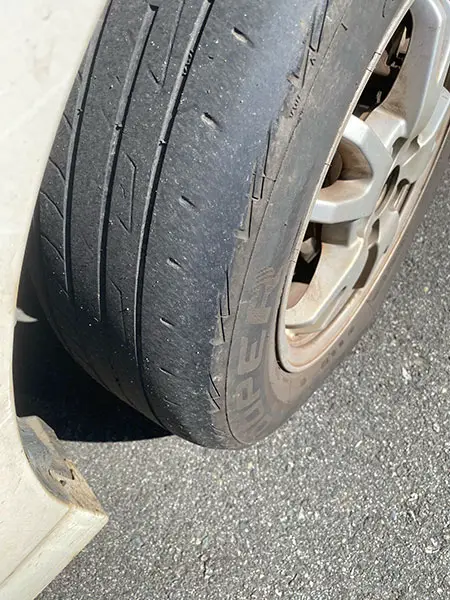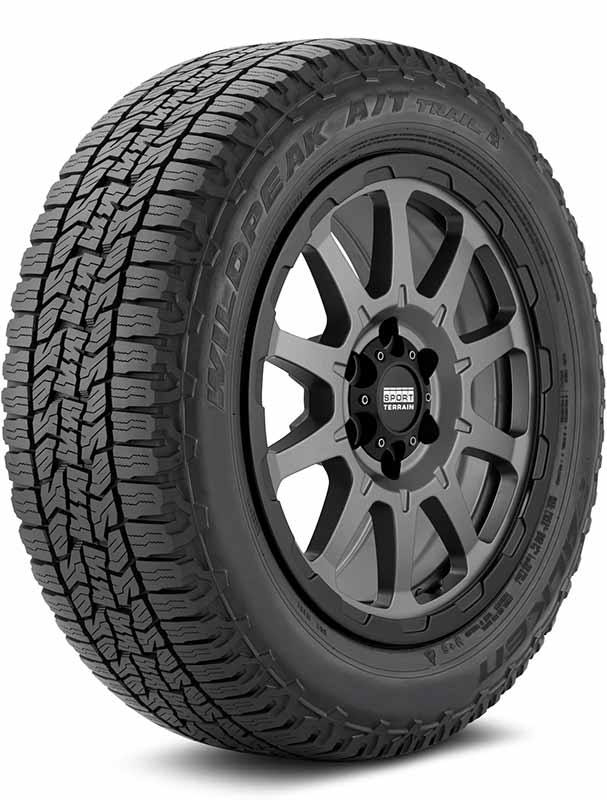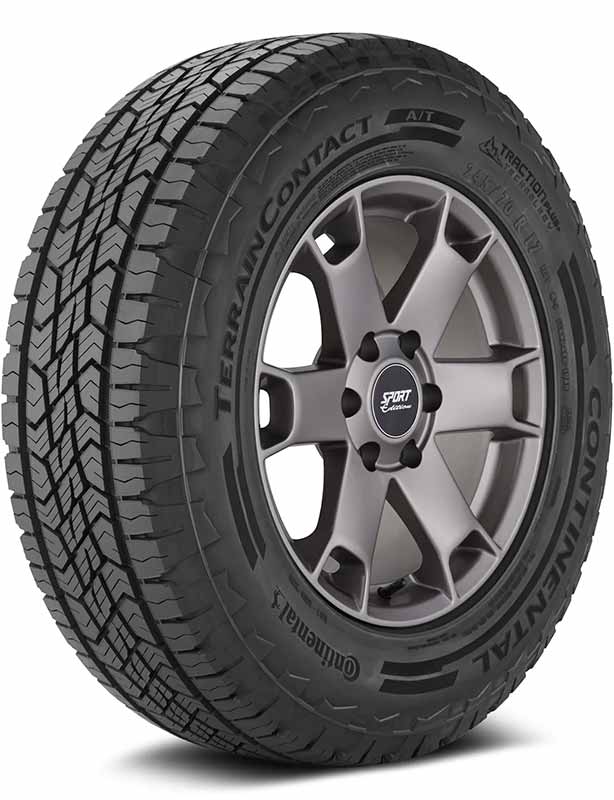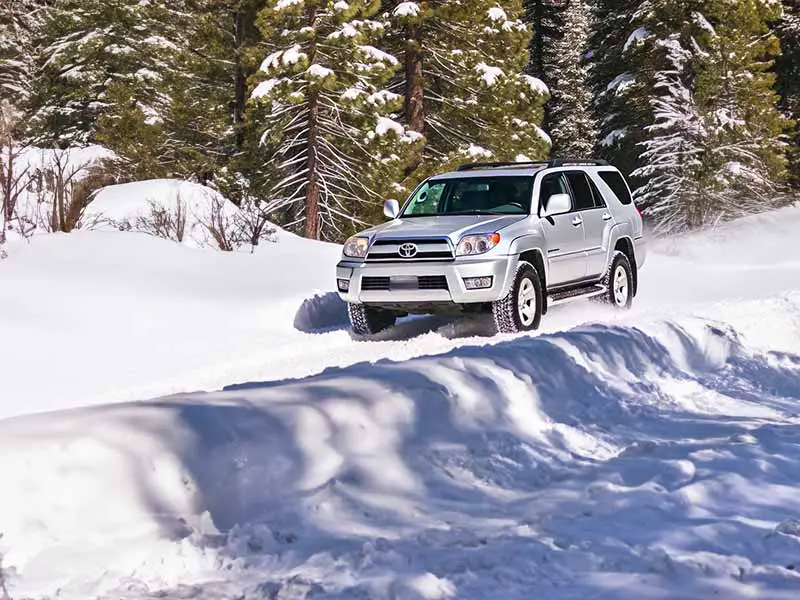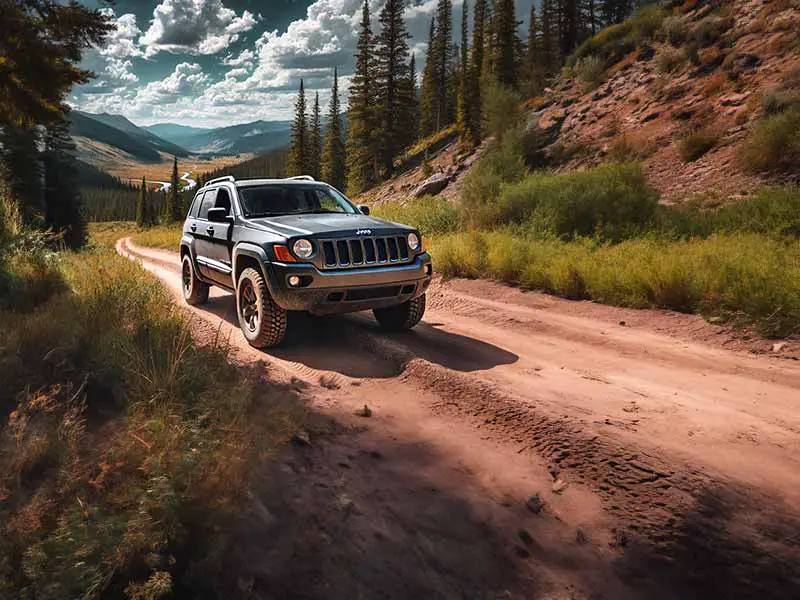Troubleshooting tire wear problems starts with identifying the tire wear pattern. An inner tire wear pattern helps us narrow down the most likely causes of the problem since there are only a few common reasons that would cause outside tire wear.
Tire Outer Edge Wear
Outer tire wear is usually caused by poor alignment. An alignment adjustment known as Toe In is the most common cause.
Other potential causes are incorrect positive camber, worn suspension components such as shock absorbers, tie rod wear, or worn ball joints.
Tire wear that isn’t even across the entire tread surface will cause tires to need to be replaced prematurely. This is obviously an expensive problem that needs to get resolved the moment you notice uneven wear.
In this quick guide, we’ll explain the some common causes and fixes. Hopefully we can find out why your tires are experiencing inner tire wear.
Let’s take a closer look.
What Causes Outer Edge Wear?
The main causes of outside tire wear are related to wheel alignment or worn suspension components.
Let’s break down the specific issues within each of these general problem areas.
Improper Wheel Alignment
Once wheel alignment is set properly, it shouldn’t drift. If your alignment is off, this is often due to damage caused from potholes, speed bumps, and curb strikes.
Small bends to suspension system components can cause minor alignment problems that can be adjusted back into spec. Larger problems will likely require replacement of suspension components to fix the alignment problem.
Toe In
Toe In can cause uneven tire wear on the outside edge. Toe refers to the tilt of your tires when looking at the vehicle from the top of your car or truck.
If the front of the tire is tilted toward from the centerline of the vehicle, this is called “toe in”. If the front of the tire is tilted outward toward the middle of the vehicle, this is called “toe out”.
Toe In is usual and most cars and trucks will have a little bit of toe in to help the vehicle feel more stable. Some outside tire wear on your front tires is not unusual. If you see some minor wear on the outside shoulder of your front tires you should rotate them to help evenly distribute the tire wear patterns.
Positive Camber Angle
Positive camber angle is a less common cause of outside tire wear. Camber angle refers to the tilt of your tires when looking at the vehicle from the front or rear of your car or truck.
If the top of the tire is tilted toward the centerline of the vehicle, this is called negative camber angle. If the top of the tire is tilted away from the middle of the vehicle, this is called positive camber angle.
Positive camber is unusual and most cars and trucks will have a little bit of negative camber to help the vehicle improve cornering grip.
If you have enough positive camber to cause significant outside tire wear you likely have some serious issues with your alignment or damaged suspension components that are contributing to this problem.
Damaged Suspension Components
All suspension system components will wear out over time. As they age, they will lose their ability to hold the wheel assembly in proper alignment.
Speed bumps, potholes, and curb strikes will accelerate wear to your suspension so take care around these common road hazards to prevent future problems.
Ball Joints
Ball joints are a critical pivot point for your suspension. There are two ball joints in your suspension – an upper and lower ball joint. A worn lower ball joint is most common.
Over time ball joints wear and will have excessive movement or play. This sloppiness in movement will allow the tire angle to drift from the vehicle’s camber angle or toe angle that should be set.
It usually takes many years or many tens of thousands of miles for ball joints to wear out. If your car or truck has some age, it may be time to have this component serviced or replaced.
Shock Absorbers
As the name implies, shock absorbers are designed to absorb shocks. Over time, they wear out just like any other suspension system components. When shocks and springs begin to wear out they lose their ability to properly control the tires rolling on the pavement.
Springs and shocks are another component that takes quite a long time to begin to wear out and fail, but if you have an older vehicle you may want to have them inspected.
Tie Rods
Tie rods are the suspension components that connect the steering rack to the steering knuckle. The ends of these connecting members have bushings that allow for some flexibility.
These bushings lose flexibility and wear over time. This allows for play and slop in the connection between the steering knuckles and tie rods. This can negatively effect toe and may also cause steering wheel play.
Tie rods can also become bent due to potholes and curb strikes. This too can cause misaligned wheels and uneven tire wear.
Control Arms
Control arms are one of the more critical suspension parts. They connect the wheel assembly to the vehicle frame.
Bent control arms or worn control arm bushings can cause bad wheel alignment and potentially lead to inner tire wear problems.
How To Fix Outer Edge Wear
To fix your tires, there are a few solutions. First and foremost, you need to replace your tires if they’re unevenly worn. This typically entails changing all four tires at the same time, so there’s no unevenness between the treads.
From there, you can diagnose what caused the problem in the first place. Make sure your tires are balanced, and go through a professional tire alignment after the installation.
Have a trained professional check the toe and camber angles of your tire. Use a pressure gauge to ensure all of your tire pressures match up with the manufacturer’s recommendation (found on a sticker in the door jamb on your driver’s door).
After that, check the ball joints, suspension, and arm bushings in your car. Any of these can cause your tires to wear prematurely along the inner edge.
Front Tires Wearing On Outside Only
When outer tire shoulder wear is only occurring on the front tires, this is usually a result of toe in. This can usually be tuned out with a proper wheel alignment, but may require replacing suspension components that are worn or even bent.
Remember, some outer edge wear on your tires is normal. Some toe in is desirable and improves the stability of your car or truck. Regular tire rotation is recommended to help evenly distribute tire wear to all four tires.
Rear Tires Wearing On Outside Only
Sports cars often have negative camber on the rear axles and will cause excessive wear on the inside tread. Even more mildly setup suspension geometries may have a bit of inner tire wear on the rear tires.
If you have outer edge wear on your rear tires this is likely due to excessive positive camber wear which would most likely be caused by damage to suspension parts due to potholes or curb strikes.
You should have your rear suspension inspected immediately for damage as positive rear camber not only causes uneven wear on the outside of your rear tires, but is extremely dangerous since it dramatically reduces handling performance during cornering.
Outer Edge Tire Wear On One Side
If your only experiencing wear on one side of car or truck you may only have an alignment issue that can be solved with a simple wheel alignment. Often however, the problem is more severe and is a result of suspension component damage due to potholes, speed bumps, or curb strikes.
No matter the circumstances, all of the same potential solutions apply and will need to be tried until the tire wear problem has been solved.
Is Outer Edge Tire Wear Dangerous?
Bald or severely low tread depth on any section of your tire’s contact patch is very dangerous in wet weather conditions.
Without sufficient tread depth, water can not be efficiently routed out from underneath the tire and can easily cause hydroplaning.
Additionally, not correcting the uneven wear can eventually wear through the tread and expose the belts and even cause a tire blowout.
Minor outer edge wear on your front tires is common and regular tire rotation should be used to help evenly distribute the unique wear patterns of each tire position around to all four of your vehicle tires.
Resources
Below are some links you may find helpful when learning about tires
- Front tires wear on the outside edge: Causes and solutions – Utires.com
- Tire wear patterns: What can cause uneven tire wear? – Allstate
Final Thoughts
There are plenty of causes and solutions for outside edge accelerated tire wear. The bottom line is that you should fix this problem as soon as you notice it — putting it off for too long can put you in danger or at least take a lot of life off your expensive tires and costing you a lot of money to replace them.
Also, be sure to check your tire pressure is set at the proper tire pressure shown on the sticker in your driver’s door jamb or owner’s manual as a part of regular tire maintenance.
Good luck and happy motoring.
